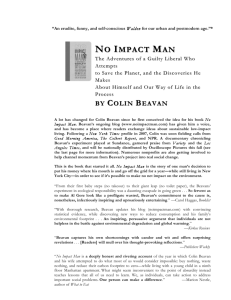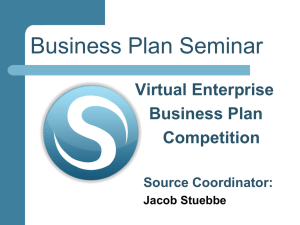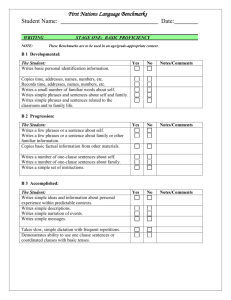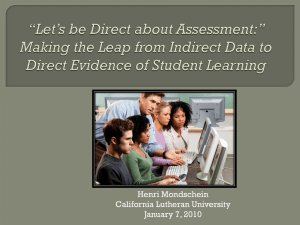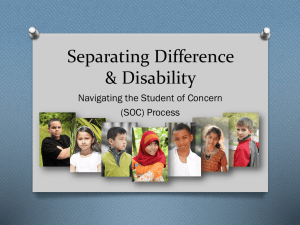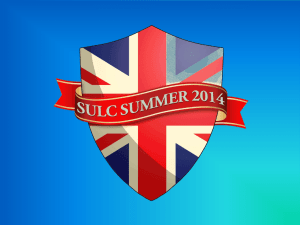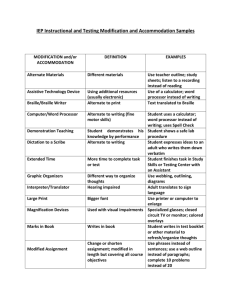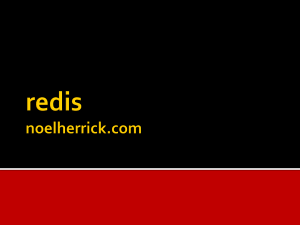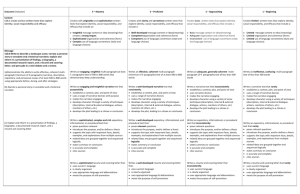Liberal Arts Study Guide
advertisement
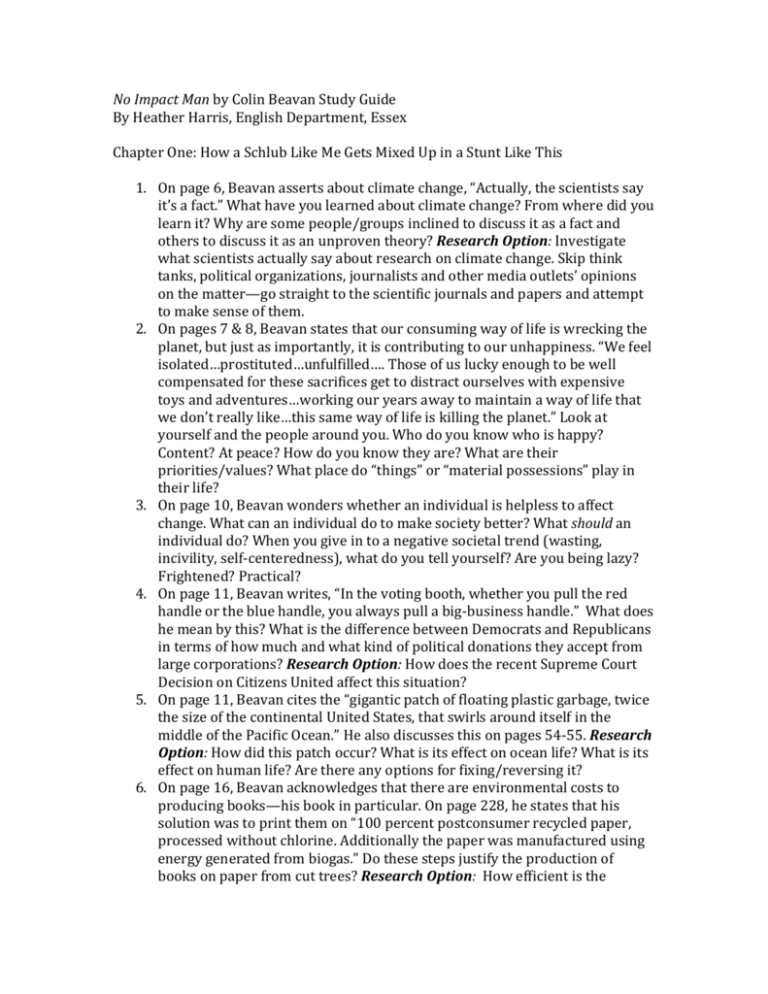
No Impact Man by Colin Beavan Study Guide By Heather Harris, English Department, Essex Chapter One: How a Schlub Like Me Gets Mixed Up in a Stunt Like This 1. On page 6, Beavan asserts about climate change, “Actually, the scientists say it’s a fact.” What have you learned about climate change? From where did you learn it? Why are some people/groups inclined to discuss it as a fact and others to discuss it as an unproven theory? Research Option: Investigate what scientists actually say about research on climate change. Skip think tanks, political organizations, journalists and other media outlets’ opinions on the matter—go straight to the scientific journals and papers and attempt to make sense of them. 2. On pages 7 & 8, Beavan states that our consuming way of life is wrecking the planet, but just as importantly, it is contributing to our unhappiness. “We feel isolated…prostituted…unfulfilled…. Those of us lucky enough to be well compensated for these sacrifices get to distract ourselves with expensive toys and adventures…working our years away to maintain a way of life that we don’t really like…this same way of life is killing the planet.” Look at yourself and the people around you. Who do you know who is happy? Content? At peace? How do you know they are? What are their priorities/values? What place do “things” or “material possessions” play in their life? 3. On page 10, Beavan wonders whether an individual is helpless to affect change. What can an individual do to make society better? What should an individual do? When you give in to a negative societal trend (wasting, incivility, self-centeredness), what do you tell yourself? Are you being lazy? Frightened? Practical? 4. On page 11, Beavan writes, “In the voting booth, whether you pull the red handle or the blue handle, you always pull a big-business handle.” What does he mean by this? What is the difference between Democrats and Republicans in terms of how much and what kind of political donations they accept from large corporations? Research Option: How does the recent Supreme Court Decision on Citizens United affect this situation? 5. On page 11, Beavan cites the “gigantic patch of floating plastic garbage, twice the size of the continental United States, that swirls around itself in the middle of the Pacific Ocean.” He also discusses this on pages 54-55. Research Option: How did this patch occur? What is its effect on ocean life? What is its effect on human life? Are there any options for fixing/reversing it? 6. On page 16, Beavan acknowledges that there are environmental costs to producing books—his book in particular. On page 228, he states that his solution was to print them on “100 percent postconsumer recycled paper, processed without chlorine. Additionally the paper was manufactured using energy generated from biogas.” Do these steps justify the production of books on paper from cut trees? Research Option: How efficient is the process of recycling paper? What is biogas? Does it emit greenhouse gases? If so, what and how much? 7. This chapter is an explanation of how Beavan came to write the book and an overview of what happened during his lifestyle experiment. Is this chapter necessary? Should this information have been evident in the main narrative of the book if he did his job as a writer? Or does writing about what one will be writing about important/useful sometimes? (Consider technical/scientific writing versus general audience writing.) Explain. Chapter Two: Day One and the Whole Thing Is a Big Mistake 1. On pages 22 & 23, Beavan writes about the initial frustration of trying to “go green.” He writes, “If I listened to the promulgated wisdom, it seemed that everything was as bad as everything else.” He went on, “‘Stasis through obfuscation,’ my wife, Michelle, called it…. ‘Greenwashing’ abounded.” He concludes, “The trick to environmental living might not be in choosing different products. Instead—at least for profligate citizens of the United States and Western Europe—it might partly be about choosing fewer products.” What are you willing to stop purchasing or purchase less? What do you know is bad for the environment but you choose to continue to purchase it, even regularly? Explain. 2. On page 24, Beavan quotes an ancient Chinese proverb that says, “The man who knows that enough is enough will always have enough.” Do you feel like you have enough? Have you ever felt like you have enough? When do you? If you don’t, why don’t you? 3. On page 26, Beavan states, “The people most satisfied with life, it turned out, had strong social connections, found meaning in their work, got to exercise what they considered to be their highest talents, and had a sense of some higher purpose.” Do you agree? How many of those traits describe you? 4. What does Beavan mean on page 26 when he states that his goal is “living on the planet’s dividends instead of its capital”? 5. On page 27, Beavan writes of the Menominee tribe, “they have figured out what the forest can productively offer them instead of considering only what they want.” Research Option: Who are the Menominee? Can their business model be applied to other natural resources? Is anyone attempting that? 6. Beavan points out on page 28, “It is a remarkable fact that, here in New York, the average citizen’s per capita carbon emissions is 29 percent of the average American’s.” He also acknowledges that Manhattan’s residents “face the highest risk in the country of developing cancer from chemicals in the air.” Where should we live if we are trying to be environmentally responsible? What are the pros and cons of living in the city, the suburbs, or the country? (This question is also a good research option, as the true pros and cons are often surprising.) 7. On page 32 and elsewhere in the book, Beavan switches from writing in the past tense to writing in the present tense. Why does he do this? Is it effective in establishing time in the book and drawing the reader in? College students often have difficulty accidentally switching between past and present tenses in their writing. What does Beavan’s writing illustrate about the importance of tense in storytelling? Chapter Three: What You Think When You Find Your Life in the Trash 1. On pages 35-36, Beavan mentions, “the throwing away of things used for less than five minutes without so much as a thought before reaching for the exact same product to use for another five minutes before throwing that away, too.” On page 48, he notes, “80 percent of our products are made to be used only once.” On page 60, he writes, “Our entire universe, apparently, is individually wrapped.” How many things do you use for less than five minutes in a day before throwing it away (coffee stirrer, napkin, tissue, food container, floss, toilet paper, etc.)? Watch yourself for a day and take note. What did you throw away so quickly that you hadn’t realized? What did you use once and throw away? On page 47, he writes, “my convenience has become the entire race’s inconvenience.” What does he mean by this? What do we owe each other regarding waste? 2. On page 37, Beavan discusses his grandparents and the “waste not, want not” generation that grew up during the Great Depression in the 1930s. He writes this: “They held dear the simple idea that we ought not to take for granted what we had been blessed with.” What does it mean to take something for granted? Why do we take things for granted? Do you know anyone born in the 1920s or earlier? Ask that person what s/he thinks it means to appreciate the things with which we have been blessed. 3. Consider this question raised on page 39: We as Americans might have a high standard of living, but do we have good quality of life? What does quality of life entail? 4. On page 41, Beavan wonders what our conveniences cost us. He writes, “ In my family’s life, the convenience doesn’t mean more time for hanging out together. It means more time for work.” Later he describes his wife this way: “She needed the raise to afford the $5,000 a year in lunches she had to buy so she could get back to her desk so she could get a raise so she could afford her lunches so she could get back to her desk….” In what ways does your ability to work any time, anywhere, and be contacted any time, anywhere, benefit you and benefit others? If you’re under 25 years old, ask someone older that question. 5. On page 43, Beavan writes of the contents of your garbage can, “you see what an archaeologist would see when he studies your life a thousand years from now.” Collect your trash and garbage for a day or dump out your container at home. What would someone analyzing your waste say about your values, priorities and lifestyle? 6. On pages 44 & 45, Beavan takes the idea of waste into the arena of war. He quotes Moses as commanding the Israelites not to destroy fruit-bearing plants during war. He goes on to say, “‘This is the law not only for trees,’ they wrote, ‘but anyone who breaks containers, tears clothes, destroys a building, stops up a well, or wastes food violates the prohibition of “do not destroy.”’” Explain what this law means to you. What would it mean for the U.S. to commit to never destroying these things during a time of war? 7. On page 46, Beavan asks, “When did taking care of ourselves become something so unimportant that it should be got out of the way rather than savored and enjoyed?...What is more important that I’m supposed to do instead?...It’s as if I’m just trying to get the whole thing over with….”” Do you cook for yourself and your loved ones? Do you eat home cooked meals with your friends and family at a table without distractions or the need to rush? How does it feel when you do these things? Why don’t we do it more often? 8. On page 47, Beavan notes that psychologists have discovered that “happy people spend a lot of time being grateful for what they have and savoring their experience. They don’t rush through ‘now’ to get to later.” What do you think about this characterization? Are there any downsides to being grateful and savoring? Does this describe you? Why or why not? 9. The U.S. throws away 10 billion pounds of disposable paper goods each year—10 billion pounds of chemically processed trees (page 48). What are our alternatives if we think this is unacceptable? How hard would it be to stop using disposable paper products? 10. Would you use a handkerchief? Why or why not? Consider trying it for a week. Chapter Four: If Only Pizza Didn’t Come on Paper Plates 1. On page 53, Beavan writes, “Around the globe, plastic bags, used for a matter of minutes and then thrown away, leave stores and markets in quantities hundreds of times greater than any other piece of merchandise.” He also notes, “China, South Africa, Ireland, Bangladesh, Taiwan, Uganda, and Tanzania had already taxed or restricted plastic bags into virtual extinction.” Should we ban plastic bags? Why don’t we, particularly women who carry handbags anyway, carry collapsible, reusable bags? Research Option: San Francisco has led the U.S. in efforts to eliminate plastic bags. How successful have they been? What has been their tactic? Is any other U.S. city attempting this? 2. On page 56, Beavan chronicles his attempt to buy a reusable fishnet-style bag. He spends all the time he had for food shopping unsuccessfully looking for this particular kind of reusable bag. Why did he do this? Why didn’t he use any other reusable bag and then buy and cook dinner? 3. On page 57, Beavan lauds loose, unpackaged, bulk food. Do you buy unpackaged food when you shop? Why or why not? The next time you grocery shop, considering buying as much as you can without packaging. How difficult or simple is it? 4. On page 58, Beavan again discusses the Menominee, who have a philosophy similar to the one printed on “Seventh Generation” cleaning and paper products. Research Option: How environmentally responsible is the “Seventh Generation” company? How do they ensure that their business model keeps in mind the well-being of their great grandchildren’s great grandchildren? 5. Evaluate the fairness of Beavan’s comment on page 59: “I’d even proved my environmental bona fides by having an argument with Michelle about whether she would make the switch from throwaway tampons to those reusable menstrual cups made from medical-grade silicon. I lost (but I’d wear her down eventually).” 6. On page 61, Beavan admits to feeling envious as he watches people around him continue to use and waste. If you have attempted to consume and waste less this semester, can you relate to Beavan’s feeling? When did reducing and reusing make you feel good? When did it make you feel frustrated? 7. On page 63, Beavan realizes that Michelle’s family buys and flaunts their purchasing power and freedom as a “sign of their overcoming difficulty.” Is this a common behavior in people? Americans? What do you think about the tension between showing people with your purchases that you’ve “made it” and living in a way that will allow the earth to be here for your grandchildren? 8. On page 64, someone says to Beavan, “‘The problem with people like you is that you don’t accept that people are basically selfish and they’re never going to change.’” Is this true? 9. On page 65, Beavan references the Keep America Beautiful public service campaign in the 1970s to encourage Americans not to litter. “They recruited fellow industrial polluters, from paper-cup manufacturers to oil companies, to help fund KAB and then use it to promote the idea that individuals rather than companies are responsible for litter and pollution.” Corporations produce an incredible amount of waste in the U.S., and they fight laws that demand they be responsible for cleaning and reducing their pollution. Is it missing the point for us to focus on individuals’ behaviors instead of corporate behavior? Research Option: How does corporate waste and pollution compare to individual carbon footprints in the U.S.? (Hint: page 68: “for all the material that ends up in our products, the manufacturing process has already trashed seventy times that much material.”) What kind of power does the Environmental Protection Agency (EPA) have to keep our environment safe and corporations responsible for their messes? 10. On page 66-67, Beavan notes that Germany has a “system called ‘extended producer responsibility,’ a policy that requires producers to be physically or financially responsible for their products, including the packaging, after their useful life. This take-back obligation gives producers an incentive to think of ways to make their products more reusable or recyclable so that fewer resources end up making a beeline for the landfill or incinerator.” Why don’t we have a policy like this in the U.S.? 11. On page 67, there is a quote from the Bhagavad Gita: “ To action alone hast thou a right and never at all to its fruits; let not the fruits of action be thy motive; neither let there be in thee any attachment to inaction.” What does this quote mean? 12. The rest of this chapter discusses human desire, the fact that we want stuff. Beavan writes about Michelle wanting to be both richer and poorer as a kid, in order to fit in. He writes about the 2,000-5,000 advertisements we see every day, many of which are on television, all of which tell us that we need to buy something or we’re “losers.” On page 132, Beavan notes that the average American watches 4.5 hours of television a day. Why do you own a television (assuming you do)? If you don’t, why not? What do the television shows you watch tell you about how you should live your life? What do you feel tempted to buy on a regular basis? Would you be willing to unplug your television (or your computer, if that’s how you watch shows) for a week? Get rid of it? Why or why not? Chapter Five: How to Reduce Your Carbon Footprint and Anger Your Mom at the Same Time 1. On pages 71 & 72, Beavan discusses air travel. Most of the world doesn’t have the resources to fly, but for those who do, “a single long-haul round-trip billows three tons of carbon dioxide into the atmosphere, as much as an entire average year of driving.” Does it matter that planes contribute a relatively small percentage of CO2 because only a few can afford it? Does this statistic make you rethink whether you will travel by plane? Does it make you rethink celebrities who “drive a Prius but still fly in private jets”? 2. Have you noticed the pull quotes in the book? (The lines from the book that are bolded, enlarged, and set off.) They are often intended to draw an uncertain reader into a story, and while they are regularly used in magazines, they are rarely used in books. Why do you think the editor decided to sprinkle them throughout this book? Do you find them helpful or distracting? 3. On page 81 are some statistics at the heart of the climate change political debate: “We must reduce carbon dioxide concentration to [350 parts per million], Hansen believes, if, in his words, ‘humanity wishes to preserve a planet similar to that on which civilization developed and to which life on Earth is adapted.’” And “The United States, with just 5 percent of the world’s population, is the largest producer of greenhouse gases, accounting for nearly 25 percent of these emissions. Meanwhile, about one-third of our carbon footprint comes from transportation. And, overall, our driving produces nearly a full half of the entire planet’s automotive greenhouse gases.” If this information makes you angry, why? If you believe this information, what can you, should you, will you do to address the contribution American driving habits are making to climate change? 4. Why, on page 81, does Beavan say it would be cruel to cancel all visits to his family, but he asks Michelle to cancel her one visit to hers? Evaluate this decision. 5. On page 82, Beavan’s mother says, “‘The train will run whether you’re on it or not. What extra emission would it cause if you just climb on?” This is the same argument as “The meat is already dead—what good would it do to be a vegetarian now?” or “So many people do [fill in the blank], what difference does it make if I do it or not?” Do you buy this argument? Is it valid, or does it have a flaw? Do you use this argument to do the things you want to do? 6. On pages 88 & 89, Beavan talks about the rhythms of weather and the seasons. He likes that he is noticing the seasons change and he laments that we have cut ourselves off from natural rhythms of life: “Those periods that interrupted the everyday rush, like a red light periodically bringing the quiet of stopped traffic, have been excised. Now peak moment follows peak moment, and they have all been accordioned together. Is that good for us? Does it make us happy?” Have you noticed fall’s arrival? Winter is coming, when many of us hope for snow days, which provide the “red light” Beavan speaks of. Is it good for people to have nature slow them down regularly? Is it bad for us that we’ve figured out ways to rush through nature’s rhythms, or is it a sign of progress and efficiency? 7. From page 92, statistics on American’s cars and driving habits: “American adults average seventy-two minutes a day behind the wheel of a car…. That’s more than twice as much time as the average American father spends with his kids…. 17 percent of the average American’s income goes toward the costs of owning and running a car…. We spend eight weeks of every year working to pay for our cars…. Americans spend the equivalent of nearly five work-months a year either driving our cars or working to pay for them….We annually spend the equivalent of 105 million weeks of vacation time sitting in traffic jams.” What else could we spend that time and money on? Why do we willing spend it on and in our cars? 8. On page 93, Beavan writes, “ People who ride bikes or walk to work are 24 percent more likely to be happy with their commute than those who drive their cars.” What does this say about the American “love affair” with the car? Dissect this statistic: Is it talking about a cause or a correlation? What’s the difference? Are there ways to explain this statistic that have nothing to do with cars? Research Option: Could you bike to work or school? Investigate local bike advocacy groups and what the city and county are doing to encourage biking as a form of transportation, just not recreation. 9. Why is the Baltimore city and county public transportation system not used by more people? Why do people stop using it when they don’t have to anymore? Why is funding good, comfortable, reliable, convenient public transportation, like the kind found in most developed countries, not a priority in the U.S. (outside of New York City)? Research Option: What happened to the trolley system that moved Baltimore City 100 years ago, until the 1950s? 10. On page 101, and several other places, Beavan mentions the attention he’s getting in the media for his project. The New York Times writes about him, and National Public Radio interviews him. He writes a blog about the project that gets a fair amount of attention, and he tracks his popularity daily. Does this attention affect how you think about Beavan’s motives for doing the project? Do you think he would have done this lifestyle experiment if he didn’t have a way to make money off of it? Does that matter? 11. When Beavan gets hit on his bike on pages 103-105, he writes, “My heart broke for the world. Feeling so vulnerable, I understood how we all wanted to protect ourselves by being inside these big, tanklike SUVs.” He goes on, “Nothing can really protect you from life’s uncertainties, after all….There was no escaping it. You never know when you’re going to be hit. There is no point wrecking the world, trying to protect myself with an SUV.” Why do people drive energy-inefficient SUVs? Should the U.S. impose miles-per-gallon minimums on automobiles to keep the size and weight of personal vehicles in check? Explain. Chapter Six: The Cabbage Diet Saves the World 1. On page 110, Beavan writes, “Instead of just thinking, How do I live without harming the environment? I find myself asking: How shall I live?” What is the connection, if any, between a responsible life and a moral/ethical life? What is the correct way to live, and how does it relate to anything we’re discussing in this book? 2. On page 111, Beavan agrees to Michelle going off birth control. He calls it a “quid pro quo for her participation in the project.” He wonders whether it is right to negotiate like this with his wife. Is it? What do you think about this? 3. On page 115, Beavan quotes a Zen master: “‘Everybody says I want this and I want that but nobody really understands this “I.”’ What is this ‘I’ that wants everything? Where does it come from? Where does it go? Why does it live? Why does it die?” Who are you? What is it about who you are that makes you want what you want? What is it about who you are that makes you able or unable to control your desires? 4. On page 117, Beavan finally starts talking about diet, which is the name of the chapter that started ten pages earlier. Were the first ten pages off topic? Would your writing instructor take points off if you’d written this for losing focus and ignoring your thesis? Why or why not? 5. On page 119, Beavan writes, “In North America, she told me, the average distance food travels from farm to plate is roughly 2,000 miles…. Agriculture, it turns out, uses a full 17 percent of the oil in the United States, which correlates to 17 percent of our oil-related greenhouse-gas emissions.” Do you ever make a point of buying local food? Do you shop at Maryland farmer’s markets and food co-ops? Why or why not? If you do, what is the difference between local food and shipped food? Research Option: Why is our food grown so far away, when Maryland has a long history of agriculture? If shipping food with trucks is so energy intensive, is there an alternative? 6. On page 121, Beavan mentions, CSAs or “community supported agriculture groups.” Look these up. Are there Maryland CSAs? How do they work? Would you consider participating? Why or why not? 7. On page 122, Beavan quotes Bill McKibben’s book, Deep Economy: “small, local farms produce more food per acre than industrial farms and use land, water and fossil fuels more efficiently. As it stands, agriculture is the United States’s leading source of water pollution, its biggest water consumer, and the main cause of soil erosion and the loss of grasslands and wetlands.” Why might smaller farms and farmers be more efficient than larger versions? Why are large farms using and polluting resources at such an alarming rate? 8. On pages 122-123, Beavan writes about fertilizer run off from farms creating “a massive bloom of oxygen-hogging algae.” We have this problem in Baltimore. Have you noticed that many years the fish die in the harbor in the spring after the first warm spell? Research Option: What are the alternatives to fertilizers that cause this problem? Are there ways to manage algae blooms so the fish don’t die? Are local farmers doing anything to help solve this problem? (Consider smaller farms, like local organic farms, and larger farms, like the chicken farms on the Eastern Shore, especially Perdue chicken farms.) How do the fertilizers suburbanites put on their lawns contribute to this problem? Is there any effort on the government’s (Baltimore City or County, Maryland State, and/or the Federal Government) part to curb the use of these fertilizers? 9. On page 123, Beavan states, “centralization of our agriculture on huge factory farms exposes us to tremendous food-security risks. In the last year, thanks to our undiversified food system, we have seen a salmonella outbreak that sickened some 160 Americans and sparked a nationwide tomato recall; the recall of E. coli-tainted spinach that sickened nearly 200 and killed 3; and a recall by a California company of 143 million pounds of beef, the largest in history.” What is centralized agriculture? What is an undiversified food system? Why is centralization inherently unstable? Can you think of other centralized models that are less effective? Research Option: Why did agriculture become centralize and undiversified in the first place? What did American farming look like 30, 60, 100 years ago? How did the Soviet Union handle their agriculture in the 1960s-1980s? 10. On pages 124-125, Beavan discusses organic farms and large single-crop farms that use nitrogen fertilizers and pesticides. What does the label “organic” mean to you? Are you willing to pay more for organic food? Why or why not? Research Option: What does the U.S. Government mean when it labels something organic? How were these standards developed? How, if at all, do they differ from the general public’s understanding of the word “organic”? Do you think these standards should be stricter? Less strict? Explain. 11. On pages 126-127, Beavan writes about the environmental havoc wreaked by cattle farming and over-fishing. Do you think about whether the meat and fish you eat is responsibly and sustainably produced? Why or why not? How old will you be in 2048, when some experts think we will have destroyed the ocean’s fisheries? How old will your children be? How would you be willing to change how you eat to make it sustainable, if at all? 12. On page 129, Beavan notes that Michelle hangs out with him in the kitchen while he cooks. Did/Do you ever spend time with someone while s/he cooked? Did/Do you cook and someone kept/keeps you company? What happens during this time in the kitchen? 13. Is it right that the Beavans have given themselves a “social exception” whereby they can eat in restaurants if they are socializing? Why did they do this? Is it cheating or acknowledging an important lesson of the project? (page 130) 14. On page 133, Beavan confesses, “It’s a luxury to be able to make all these adaptations. I’m lucky to have the time.” Is living sustainably a luxury of the rich, or can people with lower incomes do it, too? 15. What do you think about the other exceptions Beavan makes for himself: ducking into a warm café on a cold day, traveling by train and car to meet the dairy farmer? 16. Why are Americans so protective of our pets but so willing to let our food that comes from animals be treated in shockingly cruel ways? (page 135) 17. On page 137, the Beavans are shown cooking and hanging out with friends at their home, without the entertainment of television or the assistance of outof-season food. They paint a lovely picture. Why do you think he included scenes like this? (In other words, how do they relate to the themes of his book?) Why do you think their friends were drawn to this quiet lifestyle? What kinds of activities do you do with your friends? Describe the times you’ve spent with friends and family that made you feel closer to those people. Describe the times that left you feeling not as close. 18. On page 140, Beavan writes that without television, he and Michelle have sex more often. Why is television more tempting than sex, more tempting than cooking or reading or talking with people we like or almost anything, especially when we’re tired, even though all of those other things make us feel better than watching TV? Chapter Seven: Conspicuous Nonconsumption 1. On page 141, Beavan examines the American economy. He notes that we were told to go shopping in response to September 11, 2001 (research it if you’re too young to remember) and that the Gross Domestic Product, or GDP, the number that indicates how well our economy is doing, grows when more people get cancer (healthcare bills), divorced (lawyer fees), and when people are subject to natural disasters (all sorts of bills and contracts). He also notes on page 142, “40 percent of that growth goes straight to the pockets of the richest 1 percent of the population.” What does it mean to have a healthy economy? What do you want from your economy? How do you think you can get it? 2. Beavan writes the thesis of the book on page 143: “The danger, for me, is that I get attached to goals like these, find out that I’ve used up my limited time in this life on something—a Technorati rating, for heaven’s sake—that is essentially meaningless, and, meanwhile, in my tunnel vision, manage to hurt myself, the planet, and other creatures by not attending to what is really important. And then I see everyone around me doing the same thing and, quite frankly, I get scared.” Does this describe you? Does it describe your friends and family? Does it scare you? What are your alternatives? 3. How did the Zen master’s statement on page 144 affect you: “‘Soon,’ he said, ‘we will all be dead.’”? 4. On page 147, Beavan writes this of developing and undeveloped countries: “The 1 billion of us from the rich countries can go zero-impact, but if the other 8 billion still can’t afford our shiny new solar panels and windmills and they have to burn coal for a better life, we’re done for.” What do we “owe” China and India and other developing countries, simply because we are one human community with one planet of shared resources? 5. On page 149, Beavan writes, “The material is divine, [Juliet Schor] says, and we should treat it so. Our problem is that we see the material—and the associated planetary resources—as base and trash it, treating it as though it has no divine value.” What kind of mindset is required for us to waste? How are you feeling when you waste? Research Option: What does the Biblical concept of “stewardship” say about the Judeo-Christian God’s attitude toward waste? 6. On page 150, Beavan observes that companies intend for their products to go out of style and/or break so that we buy new ones. This explains how often you buy a new cell phone, a new handbag, new shoes and clothes, new furniture, and a new car. How do you feel knowing companies are trying to sell you things you’ll need to replace quickly? What kinds of things would you like to keep longer if you could? 7. On page 151, Beavan suggests that we could purchase services instead of products to keep the economy going and people in jobs without destroying the environment. This would make these jobs impossible to outsource overseas. It would sustain demand, even if the economy slowed. It would also create jobs like those in the 1950s-1970s, when the middle class was growing. Would you be willing to keep your things longer in order to have this model? 8. How do you think about second-hand shopping and consignment stores? (page 152). If you don’t participate in the second-hand economy, why? If you do, is there a reason besides cost-savings for you? Research Option: What are the second-hand economies in Baltimore? Freecycle? Craig’s List? Fashion Consignment stores? Investigate ways that people use and reuse things locally. 9. On page 161, Beavan goes back to this idea of how we should live. He writes about us not knowing for sure why we’re here and what we’re supposed to do with our time here. He uses a Buddhist nun’s term: Groundlessness. He writes, “And since we don’t know what’s happening next, it’s hard to know what we should be doing now. So we don’t really know what our lives are for. We don’t know why we were created, or who created us, or anything…. We tell ourselves [religious] stories because we don’t trust that we’ll do the right thing if we simply accept the groundlessness of not knowing.” Even if you have a deep faith, it is still faith. Do human beings have the ability to act in a loving, responsible, selfless manner without a holy text, or a faith system, or a myth that requires good behavior? How should we live, regardless of our faith system? And how do we know that is how we should live? Chapter Eight: Click and the Lights Go Out 1. On page 165, Beavan observes, “that even a rabbi should spend 10 percent of his time gardening and washing dishes and cooking and tending to the basics of daily life.” Why is this so? Do you agree? 2. One of the side effects of turning off his electricity is that Beavan anticipates experiencing “second sleep,” a middle of the night waking that happens when people go to sleep and wake with the sun. On page 166 he quotes, “Often, people might simply have lain in bed ruminating on the meaning of a fresh dream, thereby permitting the conscious mind a window onto the human psyche that remains shuttered for those in the modern day too quick to awake and arise.” Describe your sleep patterns. How well do you rest your body and mind? Why don’t you get enough sleep to wake slowly? What are you doing instead of sleeping? 3. On page 168, Beavan writes, “It was interesting to begin bumping up against the limits of individual action, to see that collective action was also completely necessary.” Some have described government as what we, the people, created to accomplish the things we can’t do alone (roads, schools, public safety, national defense, etc.). What kinds of responsible actions are well suited to individual action, and what kinds of actions are best handled by public agreement that we act together? What kinds of things are we unable to do all by ourselves or only with our families? 4. On pages 172 & 173, Beavan discusses the concept of “externalities” and how they make fossil fuels artificially cheap via a process he calls “market failure.” What are externalities? Why does Beavan argue they lead to market failure? 5. On pages 173 & 174, Beavan describes a choice we have today: Stop using coal now by using 1 percent of the worlds’ GDP on efficiency and research and development of sustainable energy, or clean up from the effects of climate change (floods, hurricanes, droughts, food shortages, epidemics) later using 20 percent. 1 percent versus 20 percent. It’s the old adage “A stitch in time saves nine.” Why right now are we choosing the more expensive option that will also cost human lives? 6. In a comment that reminds us of the “Keep America Beautiful” campaign, Beavan’s friend says, “‘Of course the corporate media love you. You’re out there telling us all that individually we should use less electricity and distracting everyone from the fact that industry is killing us. You’re out there worrying us about littering while they get away with killing the world” (page 181). In the documentary, that same friend says that Michelle’s job writing for a business magazine, promoting corporate power, is working against everything the No Impact project stands for. Is Beavan accomplishing anything good with this project? Or is he just a cog in the corporate machine, making sure that the real polluters and destroyers of our physical and emotional well-being are able to keep up business as usual? 7. Why does Beavan feel “weird and ashamed” (page 183) at his electricity cutting party? Why does the party end fifteen minutes after he cuts the power, leaving him feeling “awful” (page 184)? This seems particularly strange since he writes about how his other measures brought his friends and family closer. 8. On page 184, Beavan writes that the hardest part of this project was changing his habits. “A month,” he writes. “That’s how long they say it takes to change a habit.” Are you willing to struggle for a month against your desire to “fall back into the rut” in order to make any part of your life more sustainable? Which part? If not, explain. 9. In the documentary, we see the Beavans borrowing ice from their neighbor in order to keep their food cool after the pot-in-pot method fails. Why didn’t he include this in the book, especially since he admitted to other failures? 10. On page 187, Beavan suggests that we “turn the great minds that brought us the Nintendo Wii to, say, getting fresh water to the 1 billion people on our planet who don’t have it.” That sounds like a reasonable suggestion. What other aspects of sustainability could new technology address? Describe why you think something like that will or will not happen. Chapter Nine: Trying to Do Enough Good to Outweigh the Harm 1. Clean drinking water is a growing problem, both domestically and internationally (pages 193-194). Do you let the tap run at home? Do your faucets drip? Why do we not feel the coming shortage? Research Option: What are some ways that Americans can reduce the seventy gallons of water we use daily? What are gray water options? How do people in Western Europe and Japan use so much less water than we do? 2. Storm-water runoff overflows American city sewer systems regularly (page 195) dumping sewage into waterways. In Baltimore, storms cause raw sewage to dump into the Harbor. Research Option: Why does this happen? What are the solutions? How old is Baltimore City’s water infrastructure? Does the city have plans to improve the infrastructure so that it fails less often? If not, why not? 3. The chemicals we use, ingest, and spray are interfering with our hormones and the hormone balances in animals (page 195). Many of them mimic estrogen and cause female traits in males and reproductive problems in females. Research Option: What kinds of regulations are pending to protect the reproductive health of animals and people? Why have we allowed this level of chemical contamination to happen to our water supplies? 4. On page 196, Beavan writes, “Bottled water, by the way, keeps no one safe, since the U.S. government does not require that bottled water be tested for these types of chemicals.” Do you pay for bottled water instead of using tap or drinking fountain water? If so, why? What has the bottled water industry led you to believe about bottled water versus tap water? Research Option: Where does bottled water come from, particularly Dasani (Coca-Cola product) and Aquafina (Pepsi product), which have a huge market share? Do the bottled water companies pay for the water they are charging you for? If so, how much? What kind of quality control do they do to make sure the water is safe? How does that compare to the quality control that American cities do to make sure their tap water is safe? 5. What does it mean to “privatize drinking water” (page 197)? Consider the possible differences between a private company owning water supplies and local governments being in charge of municipal water supplies. Research Option: Have water supplies been privatized anywhere in the world (Hint: look at Bolivia)? What was the effect? 6. What does Beavan mean when he writes on page 203, “Environmentalism is not about the environment. It is about people. It is about vision for a better life—for people”? 7. What does Beavan mean when he writes on page 206, “paradoxically, when we imagine we don’t make a difference, that is when we do the most harm”? 8. Sharon (pages 207-208) has asthma in part because she lives in an area of New York City near the garbage processing plants, and the trucks spew toxic fumes. Where do you expect that we put these plants in most American cities? Why? Research Option: Where does garbage go in Baltimore city and county? What is around those plants? 9. On page 210, Beavan writes, “This is the root of my religious belief: we are not separate.” What are the implications of believing that all life is one life, that we are all a part of one connected living thing? Do you believe this? Explain. 10. Strunk and White in their famous book on writing, The Elements of Style, tell writers that the “proper place for what is most prominent is the end,” (33). In other words, your last word or idea should be the most important, whether in a sentence, paragraph, or entire composition. The last words of Beavan’s book are, “I turn the lights back on” (page 210). Why do you think he ended the main portion of the book this way? What other options might he have had? How would you have ended this book if you had written it? Epilogue: Life After the Year Without Toilet Paper 1. Why does Beavan title the epilogue as he does since the issue of toilet paper annoys him so much? 2. On page 214, Beavan asks, “If the pleasures we seek are not permanent, then how important are they?” What is a permanent pleasure? Why would a permanent pleasure be superior to a temporary pleasure? If they are superior, why do any of us seek temporary pleasures? 3. On page 216, Beavan writes about the importance of peace: personal, family, community, domestic, and international peace. How does peace relate to the issues of the environment? How is the fact that most of us are at war on each of these levels, at least to some degree, affect our ability to care for our environment? 4. On page 218, Beavan writes, “In an economy based on delivering the most stuff to the most people, education and healthcare are still secondary priorities.” We are a rich and clever people. If we wanted to deliver affordable, effective, competitive healthcare and education to every 5. 6. 7. 8. American, for the sake of the strength and well-being of every American and our country as a whole, we could. Why don’t we? What needs to change for education and health to be a priority in the U.S.? Throughout the book, Beavan uses rhetorical questions to make his points. Your instructor probably discourages you from posing questions you do not immediately answer in your writing. Why does Beavan do this? Is it effective? Go back and locate some of these questions and use specific examples in your answer. Beavan also uses anecdotes throughout this book, stories from his life and his family’s that are meant to illustrate principles of the book, particularly things that were difficult during the project. Why does he do this? Do these stories add up to a narrative arc, a story with a beginning, building action, a climax, and a resolution? Did Beavan create believable characters in himself and Michelle? How well did Beavan use stories to emphasize the human experience of environmentalism? Who was Beavan’s intended audience for this book? Who was not? How do you know? How well did he address his audience? How could he have broadened his audience? What would he have lost and gained by doing that? Let’s look at the last line again. On page 224, Beavan writes as the last line of the entire book, “So, what are you going to do?” He made a point in the beginning of the book about not preaching, about focusing on himself and changing his habits. Did he keep that focus throughout the book? Why or why not? And if that was his goal, speculate about why he ended the book the way he did. Was it effective or ineffective? Explain.
